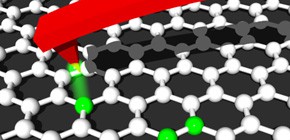
Chemically reactive probe tip plays role in effectively moving atoms at room temperature
a step toward the development of more precise nano-devices
The following were involved in this research: ABE Masayuki (Associate Professor, Graduate School of Engineering, Nagoya University) an Academy of Sciences of the Czech Republic Group , a Universidad Autónoma de Madrid Group , SUGIMOTO Yoshiaki (Associate Professor, Graduate School of Engineering, Osaka University), MORITA Seizo , (Professor) and Yurtsever Ayhan (Lecturer, Institute of Scientific and Industrial Research, OU). This joint group, using scanning probe microscopes, succeeded in clarifying conditions for moving an atom on a silicon (Si) surface. Specifically, it was found that moving a silicon atom was possible when the force interacting between the probe and the atom was greater than 1.5 nN, but it was impossible when the force was less than 1.5 nN. It is also very significant that this group's research into atom manipulation was conducted in experiments at room temperature. From these findings, it was found that the probe tip needed to be chemically reactive for moving atoms on a Si surface.
If effective atomic manipulation becomes possible by controlling the activation level at a probe tip, it will lead to the possible development of nano materials and nano devices by designing theoretically based nano-structures.
Abstract
The effect of tip chemical reactivity on the lateral manipulation of intrinsic Si adatoms toward a vacancy site on a Si(111)-(7×7) surface has been investigated by noncontact atomic force microscopy at room temperature. Here we measure the atom-hopping probabilities associated with different manipulation processes as a function of the tip–surface distance by means of constant height scans with chemically different types of tips. The interactions between different tips and Si atoms are evaluated by force spectroscopic measurements. Our results demonstrate that the ability to manipulate Si adatoms depends extremely on the chemical nature of the tip apex and is correlated with the maximal attractive force measured over Si adatoms. We rationalize the observed dependence of the atom manipulation process on tip-apex chemical reactivity by means of density functional theory calculations. The results of these calculations suggest that the ability to reduce the energy barrier associated with the Si adatom movement depends profoundly on tip chemical reactivity and that the level of energy barrier reduction is higher with tips that exhibit high chemical reactivity with Si adatoms. The results of this study provide a better way to control the efficiency of the atomic manipulation process for chemisorption systems.

Figure 1

Figure 2

Figure 3
To learn more about this research, please read the full research report entitled " Role of Tip Chemical Reactivity on Atom Manipulation Process in Dynamic Force Microscopy " at this page of the ACS Nano website.
Related link :
